Co-authored with “Hidden Opportunities”
Market price action is often disconnected from the business fundamentals, profitability, debt management, and pricing power. Let us look at similar disconnects that sharply affected the prices of mega-cap despite a lack of tangible impact to the business.
In the early 2000s, Coca-Cola (KO) faced criticism and declining sales due to concerns about the health effects of sugary soft drinks. This led to several years of stagnant or declining stock prices as the market refused to look past those concerns. But during that decade, KO’s revenue grew by 50% in 10 years, and the company raised its dividend from $0.17/share to $0.59/share almost 4x. Stock prices eventually recovered and patient investors were rewarded with healthy total returns. Source
Macrotrends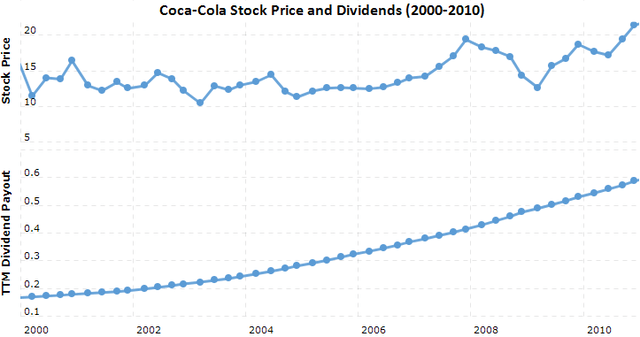
A similar situation happened with Microsoft (MSFT). During the dot-com bubble burst in 2000, Microsoft’s stock price declined due to a broader tech market correction. However, the company’s dominance in Operating Systems and Office Suite products kept business fundamentals strong, and market prices eventually rebounded to massive gains.
Similarly, we examine two very dividend-friendly industries that have sharply sold off amidst uncertainties over interest rates. Both have seen a healthy increase in industry-average dividend payments YTD and are available at desirable prices. Let’s dive in!
Pick #1: UTG – Yield 8.8%
The utility sector has had a difficult trading cycle. As the long-term Treasury yields rose, these bond proxies experienced a steep sell-off to reflect their higher risk than guaranteed financial instruments. At this time, a few notable utility firms like CenterPoint Energy (CNP), CMS Energy Corp (CMS), DTE Energy (DTE), Ameren Corp (AEE), WEC Energy Group (WEC), Xcel Energy (XEL), Entergy Corp (ETR), FirstEnergy Corp (FE), and NorthWestern Energy Group (NWE) sport low forward PE ratios and are materially undervalued. Several of these firms have seen rating upgrades amidst market turbulence, further supporting their business execution through these elevated interest rates, and shareholder dividends will continue to grow.
“annual dividend growth for electric utilities to average around 5%, in line with earnings growth. The fundamental outlook for utilities continues to be very, very strong” – Bobby Edemeka, Portfolio Manager, PGIM Jennison Utility
Utility, phone, and internet bills will be sent to residents monthly. Despite household financial struggles, these expenses cannot be cut or eliminated from their budgets as they are essential for everyday living or business operations. Operations are stable, and revenues are reliably recurring, making the dividends safe.
Reaves Utility Income Fund (UTG) is an actively managed CEF that provides a diversified exposure to this critical sector, cushioning shareholders from individual firms that may experience capital crunch or debt refinancing challenges (which aren’t that many as hydrocarbon-based energy firms maintain robust balance sheets at this time). Source
UTG Fact Sheet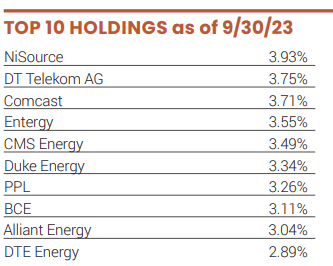
As of August 2023, UTG held 52 individual securities (Common stock, preferreds, and bonds) from 44 companies with the following sector composition.
Author’s Calculations based on UTG August 2023 Holdings report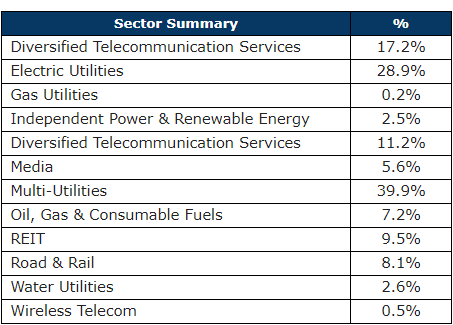
UTG’s electric utility companies maintain investment-grade rated balance sheets, and several recently received credit rating upgrades from leading firms. The overall exposure is diversified through other quasi-utility and infrastructure-oriented companies like telecom, tower REITs, and road and railroad stocks, whose services continue to see adoption and growth through challenging economic conditions.
With UTG in your portfolio, you get paid monthly to wait for that and potentially reinvest some of your dividends to add to your holdings. The CEF trades almost at par with NAV, making it a suitable buy through the market uncertainty. The CEF distributes $0.19 every month, a healthy 8.8% yield. Consumers using electricity, gas, water, and other essentials are the unsung heroes behind my monthly dividend show from UTG.
Pick #2: RQI – Yield 9.1%
We are facing tighter credit conditions amidst rising interest rates, and REITs are another equity class facing the brunt of it, at least in sentiment.
“The knee-jerk reaction to sell REITs on the prospects of rising interest rates flies in the face of some long-term data that suggest that REITs can—and have—performed quite well in rising interest rate environments” – T. Ritson Ferguson, CEO and co-CIO of CBRE Clarion Securities in 2015
Today’s REITs are much better equipped to handle higher rates than the pre-GFC days. Leverage ratios remained modest, with debt-to-market assets at 34.6%, and the weighted average term-to-maturity of REIT debt was nearly seven years, with a weighted average interest rate on total debt of 3.7%. This means several high-quality REITs will easily ride out this rate cycle without refinancing.
“REITs are ably handling tighter credit conditions and the ongoing high interest rate environment, in large part because of their solid balance sheets and sound operational performance” – Nareit Executive Vice President of Research & Investor Outreach John Worth
Despite mortgage market turmoil and other economic headwinds, REITs displayed operational strength during Q2, with two-thirds of the companies reporting quarterly FFO increases, notably in industrials, lodging, healthcare, and infrastructure. FFO of $20.6 billion represented a 4.2% YoY increase, and Same Store NOI (Net Operating Income) experienced 5.0% YoY gains, emphasizing that REIT income is keeping pace with inflation. Most importantly, REITs paid out $3 billion in dividends, a 4.5% YoY increase.
This is an income investor-friendly industry, and we seek high yields amidst discounted prices. And it helps if we can get diversified access to the entire sector. Cohen & Steers Quality Income Realty Fund, Inc. (RQI) is a CEF with 186 REIT holdings, with its top 10 portfolio constituents representing 50% of the market value. These are some of the highly-rated operators with excellent operational resilience and balance sheet quality. Source
RQI Fact Sheet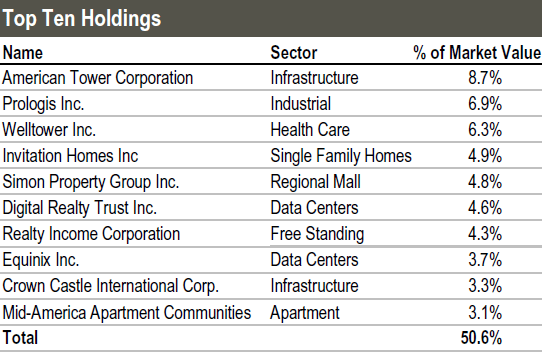
Despite RQI underperforming the broader market during the past rate hike cycle, the fund rebounded following three significant rate cuts with substantial outperformance in 2019.
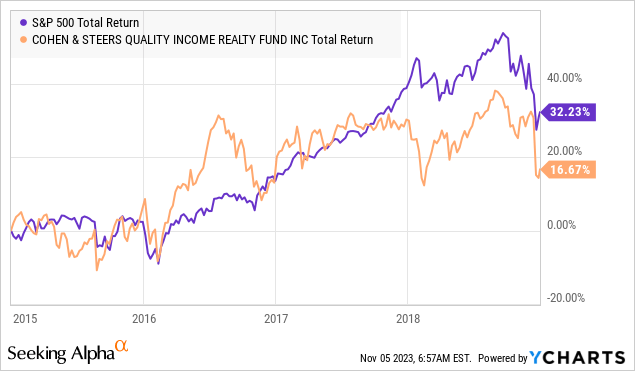
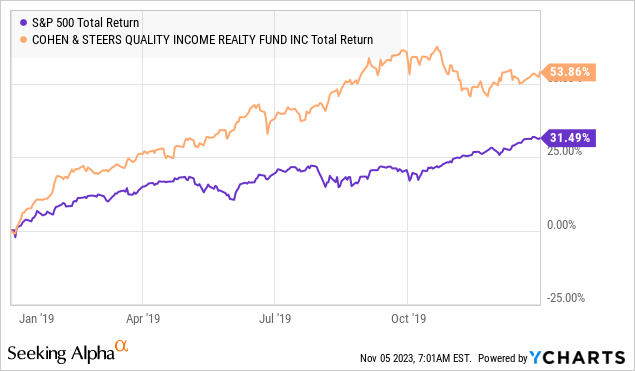
Considering the overall positioning of REITs at this time, this result is likely to repeat soon.
RQI is modestly leveraged at 32% of managed assets, but 81% of the borrowings carry fixed interest rates (1.8%) with a weighted average term of 2.8 years. The fund carries a modest 2.6% cost of all financing.
RQI’s YTD distributions (including the special distribution paid in January 2023) comprised Net Investment Income and Long Term Capital Gains with no ROC component.
Author’s Calculations
The CEF’s $0.08/share monthly distribution calculates to a 9.1% annualized yield. RQI is priced at a bargain 7% discount to NAV, making it an excellent income source to add to your portfolio amidst widespread market uncertainty.
Conclusion
Market-price-wise, Utilities and REITs have had a rough year. However, looking under the hood, we see strong profitability, and leaders have made healthy raises to their dividends. Interest rates will not go up forever; they will peak soon and then drop; that is how the economic cycle works. Buying beaten-up dividend payers from robust sectors like REITs and utilities will position investors well for sustained income and capital appreciation. A quick look at market leaders and well-established players in these sectors shows that pricing power remains strong, profitability is growing, and shareholder dividends are being raised. As such, we aren’t using chart patterns and market sentiment indicators to shy away from quality securities from this sector.
We are buyers of discounted dividend payers and don’t shy away from short-term market sentiment. Our objective is to build a sustainable income stream that can provide for our retirement through varying economic conditions surrounding us. Our “model portfolio” includes +45 high-yield picks with an overall yield of +9%.
Every dividend we collect keeps us closer to our goals, and we are winning while Main Street anxiously awaits the next move by the Fed. RQI and UTG present strong buys for reliable income, with up to ~9% yields.
Read the full article here







